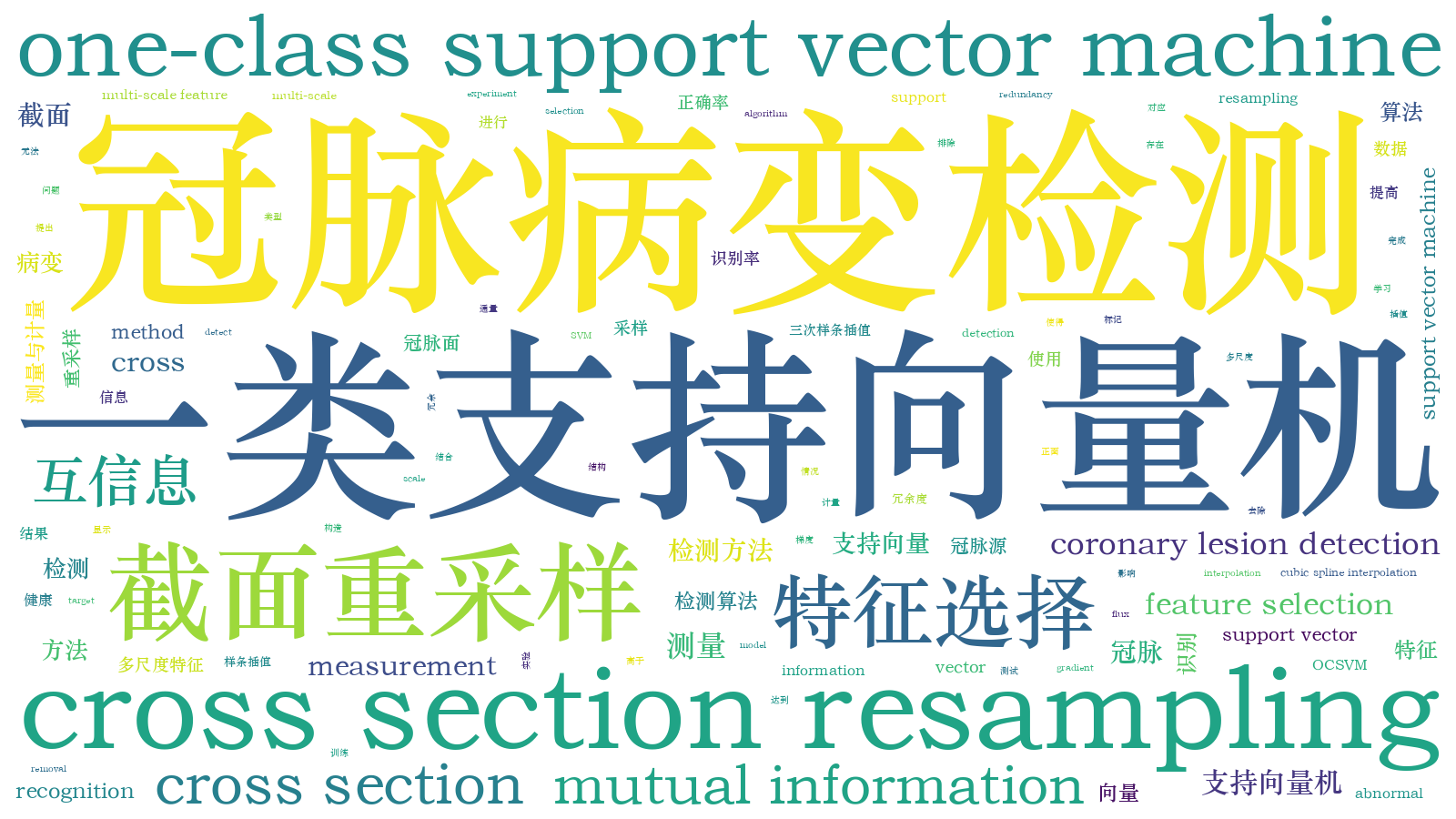基于一类支持向量机的冠脉病变检测方法
[1] 陈伟伟, 高润霖, 刘力生, 等. 《中国心血管病报告2015》概要[J]. 中国循环杂志, 2016, 31(6): 617-622.
Chen Weiwei, Gao Runlin, Liu Lisheng, et al. Outline of 《China cardiovascular disease report 2015》[J]. Chinese Circulation Journal, 2016, 31(6): 617-622.
[2] Maurovich-Horvat P, Ferencik M, Voros S, et al. Comprehensive plaque assessment by coronary CT angiography[J]. Nature Reviews Cardiology, 2014, 11(7): 390-402.
[3] 陈相廷, 张 帆, 张一凡, 等. CT造影冠状动脉狭窄检测与量化的相关研究[J]. 激光与光电子学进展, 2015, 52(8): 080006.
[4] 李 磊, 韩 玉, 席晓琦, 等. X射线CT转台单侧两次螺旋扫描单层重排重建算法[J]. 光学学报, 2016, 36(9): 0934001.
[5] Kang D, Slomka P J, Nakazato R, et al. Automated knowledge-based detection of nonobstructive and obstructive arterial lesions from coronary CT angiography[J]. Medical Physics, 2013, 40(4): 041912.
[6] Tessmann M, Vega-Higuera F, Fritz D, et al. Multi-scale feature extraction for learning-based classification of coronary artery stenosis[C]. SPIE, 2009, 7260: 726002.
[7] Freund Y, Schapire R E. A decision-theoretic generalization of on-line learning and an application to boosting[J]. Journal of Computer & System Sciences, 1997, 55(1): 119-139.
[8] Zuluaga M A, Magnin I E, Hernández H M, et al. Automatic detection of abnormal vascular cross-sections based on density level detection and support vector machines[J]. International Journal of Computer Assisted Radiology and Surgery, 2011, 6(2): 163-74.
[9] Zuluaga M A, Hoyos M H, Orkisz M. Feature selection based on empirical-risk function to detect lesions in vascular computed tomography[J]. IRBM, 2014, 35(5): 244-254.
[10] Zuluaga M A, Hush D, Leyton E J F D, et al. Learning from only positive and unlabeled data to detect lesions in vascular CT images[C]. International Conference on Medical Image Computing and Computer-Assisted Intervention. Springer-Verlag, 2011: 9-16.
[11] 李俊威, 陈晓冬, 贾忠伟, 等. 基于光线投射法的冠脉血管腔壁分割算法[J]. 中国激光, 2015, 42(8): 0804002.
[12] 张朝霞, 陈晓冬, 单建丰, 等. 基于多层螺旋CT血管分析的感兴趣冠脉段最佳造影角度计算[J]. 中国激光, 2011, 38(11): 1104003.
[13] Lesage D,Angelini E D, Bloch I, et al. A review of 3D vessel lumen segmentation techniques: models, features and extraction schemes[J]. Medical Image Analysis, 2009, 13(6): 819-845.
[14] Zuluaga M A, Leyton E J F D, Hoyos M H, et al. Feature selection for SVM-based vascular anomaly detection[C]. Medical Computer Vision. Recognition Techniques and Applications in Medical Imaging - International Miccai Workshop, Mcv. 2010: 141-152.
[15] 辛 竹, 周亚建. 文本分类中互信息特征选择方法的研究与算法改进[J]. 计算机应用, 2013, 33(s2): 116-118.
Xin Zhu, Zhou Yajian. Study and improvement of mutual information for feature selection in text categorization[J]. Journal of Computer Applications, 2013, 33(s2): 116-118.
[16] 姚 旭, 王晓丹, 张玉玺, 等. 特征选择方法综述[J]. 控制与决策, 2012, 27(2): 161-166.
Yao Xu, Wang Xiaodan, Zhang Yuxi, et al. Summary of feature selection algorithms[J]. Control and Decision, 2012, 27(2): 161-166.
[17] Battiti R. Using mutual information for selecting features in supervised neural net learning[J]. IEEE Transactions on Neural Networks, 1994, 5(4): 537-550.
[18] 王 皓, 孙宏斌, 张伯明. PG-HMI: 一种基于互信息的特征选择方法[J]. 模式识别与人工智能, 2007, 20(1): 55-63.
Wang Hao, Sun Hongbin, Zhang Boming. PG-HMI: mutual information based feature selection method[J]. Pattern Recognition and Artificial Intelligence, 2007, 20(1): 55-63.
[19] Schlkopf B, Smola A, Williamson R, et al. New support vector algorithms[J]. Neural Computation, 2000, 12(5): 1207-1245.
[20] Cortes C, Vapnik V. Support vector network[J]. Machine Learning, 1995, 20(3): 273-297.
[21] Avila L S, Barre S, Blue R, et al. The VTK user′s guide[M]. Clifton Park: Kitware, 2010.
[22] Chen Y W, Lin C J. Combining SVMs with various feature selection strategies[J]. Studies in Fuzziness & Soft Computing, 2006, 207: 315-324.
赵聪, 陈晓冬, 张佳琛, 汪毅, 贾忠伟, 陈向志, 郁道银. 基于一类支持向量机的冠脉病变检测方法[J]. 中国激光, 2017, 44(5): 0504006. Zhao Cong, Chen Xiaodong, Zhang Jiachen, Wang Yi, Jia Zhongwei, Chen Xiangzhi, Yu Daoyin. Coronary Lesion Detection Method Based on One-Class Support Vector Machine[J]. Chinese Journal of Lasers, 2017, 44(5): 0504006.






